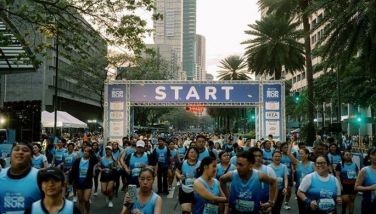Awareness campaign

The official figures are in: 19 million foreigners visited Thailand last year.
The arrivals could have hit 22 million, Thai Ambassador Prasas Prasasvinitchai told me, had it not been for the devastating floods in the fourth quarter of the year that affected even the capital Bangkok.
Compare the figure to the 3.9 million arrivals in our country in 2011 - an increase of 11.28 percent from the previous year’s 3.52 million - and you wish the new Philippine tourism program had a successful global launch.
“It’s more fun in the Philippines” was unveiled before the international travel industry last week. The venue happened to be the five-day International Tourism Bourse or ITB-Berlin.
Germany is hardly the best place for the Philippines to pitch itself as a travel destination. From the moment you land at the sprawling aviation hub in Frankfurt, you are reminded of Fraport AG, operator of the airport, and its continuing travails for doing business in the Philippines.
But ITB-Berlin is portrayed as the world’s leading travel trade show, with 169,295 visitors and 11,163 exhibitors recorded at the event held in March last year. Participants can have a year’s quota of bookings and tour packages filled at such a trade show. The Philippines needed to have a presence at ITB-Berlin last week, and an international trade show is a proper venue to roll out the new Philippine tourism campaign.
So Tourism Secretary Ramon Jimenez, according to news reports, went to the ITB with representatives of 19 hotels, resorts, travel agencies and tour operators. Among the destinations they promoted were Bohol, Boracay, Cebu, Negros Oriental, Palawan and, why not, even Metro Manila.
A European capital is a good venue to launch the new Philippine tourism campaign, considering that the country is not on the radar screen of the average European traveler. Diplomats, businessmen and other people from various countries in Europe have told me this.
The low awareness is two-way, as European diplomats have also noted. While millions of Pinoys are working in Europe, the Middle East and North Africa, the average Pinoy traveler is still focused on the Asia-Pacific region.
Our neighbors such as Thailand, on the other hand, are way ahead of us in marketing their countries to European tourists.
* * *
It helps Thailand a lot that it is an international aviation hub, with direct flights by various carriers between Bangkok and numerous European countries and other capitals around the world. From Bangkok, it’s a short plane ride to other popular Southeast Asian destinations such as Siem Reap in Cambodia, Bali in Indonesia, Singapore, and Ho Chi Minh and Hanoi in Vietnam.
In contrast, the last direct flight between Europe and the Philippines will fly out of the NAIA at the end of the month, during the summer peak season for travel. Like other foreign carriers, KLM Royal Dutch Airlines decided to pack up because of the common carrier’s tax that the Philippine government refuses to lift.
So come April, there will be one fewer foreign carrier to tax, and even fewer travelers especially from Europe. I hope this little detail didn’t give the Philippines’ tourism group too much trouble in ITB-Berlin.
Direct flights are faster and cheaper. Once a European traveler has hopped from Bangkok to Phuket to Chiang Mai and then to Siem Reap and Ho Chi Minh, will he still have time and energy left to proceed to Manila before making a U-turn back to Europe? We need to get travelers to first see Boracay and the whale sharks in Donsol before they fly to the rest of Southeast Asia.
Our local carriers cannot fill the void because they cannot fly to Europe and several US cities due to our aviation security downgrade.
The KLM crew, instead of staying overnight in Philippine hotels, will stay instead in Hong Kong. That’s 20,000 nights a year lost for our hotels.
With more flights to Hanoi, Vietnam could leapfrog ahead of us in terms of international tourist arrivals. A colleague who flew to Hanoi a few days ago said Halong Bay, a UNESCO World Heritage Site, was packed with tourists.
Vietnam already surpassed the Philippines in 2011, recording over six million foreign tourist arrivals. In the first two months of this year, it had 1.3 million foreign visitors.
* * *
Tourism is a major revenue earner, and it can help lure back the millions of Filipinos who have been forced to leave their families to work overseas.
The World Travel and Tourism Council reports that the travel industry accounts for 258 million jobs around the world and $6 trillion in global GDP (about 9.1% of the total) - larger than the automotive industry (8% of global GDP) and slightly smaller than banking (11%).
Council president and CEO David Scowsill said, in a message ahead of ITB-Berlin 2012, that the industry’s key challenge “is to stimulate jobs and investment, eliminating barriers to travel such as visa restrictions, taxation, and outmoded infrastructure systems.”
Tourism infrastructure is another area that has long cried out for upgrading in the Philippines. Many foreigners have pointed out to me that we lack decent accommodations, and those that are available are expensive when compared with those of similar quality in neighboring countries.
Travelers with money to spend want something more than backpacker accommodations. Even backpackers - many of them youths who can become CEOs one day, or who blog extensively about their experiences - cannot find enough accommodations at reasonable prices.
One diplomat told me he had to scrap a plan to visit Batanes (a must-see destination, I tell foreigners) because he found the cost of the tour package for five days and four nights in two-star accommodations exorbitant.
Foreigners also look for different types of attractions in one destination. One of them told me that from the beach, people want to go shopping for souvenirs, visit nearby museums, relax in a café. One of the new diplomats noted that tourists from their country who visit Metro Manila also want to buy souvenirs right at the destination sites instead of at shopping malls.
Former tourism chief Bertie Lim had this in mind in his “cluster tourism development” that he proposed to President Aquino, but which I guess put P-Noy to sleep.
The tourism cluster has been replaced by a marketing blitz anchored on having fun in the Philippines. The marketing can succeed only if other sectors do their part in making the travel industry a major engine of economic growth.
- Latest
- Trending
























